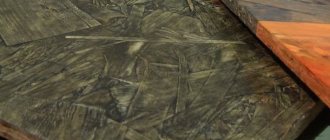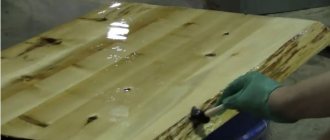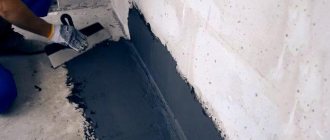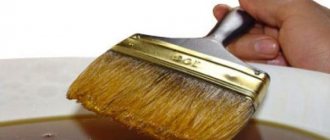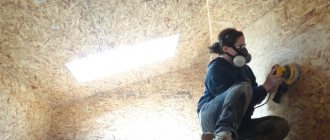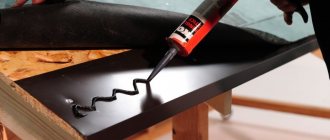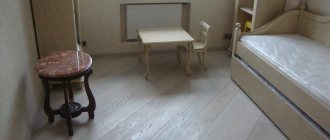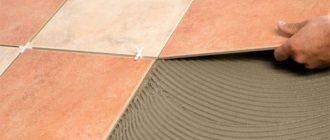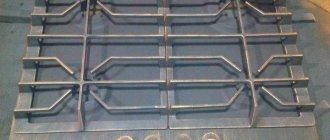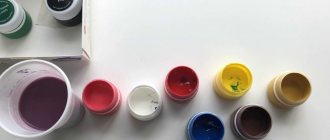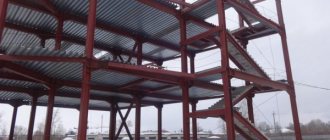OSB is one of the most popular materials in construction. The popularity of the slabs is explained by their high technical and operational characteristics and versatility. However, due to the inherent characteristics of all wood derivatives, when working with OSB, you should adhere to a certain technology and use specialized finishing materials. With the help of a Soppka specialist, we will consider:
Specifics of using OSB
Moisture resistance of OSB
Options for protecting OSB from exposure to atmospheric factors
The need to use specialized protective and decorative means
Conclusion
Types of OSB
OSB is classified according to various parameters. These are resistance to moisture, strength characteristics, the presence of locking joints, environmental friendliness, and thickness of the material. The following varieties can be distinguished:
- OSB-1 is a board with low strength properties and poor resistance to moisture. Usually used as an additional building material. They are inexpensive and are often used when it is necessary to create temporary formwork.
- OSB-2 is a durable board with low resistance to moisture. Used when carrying out work in rooms with low humidity levels. Can be used for covering light indoor partitions.
- OSB-3 is a universal board. Used in rooms with any level of humidity, as well as outside. They are used for cladding walls, forming floors between floors, and laying subfloors for decorative coating. They are often used when it is necessary to create a continuous sheathing for certain types of roofs. Used in the construction of frame houses and garages.
- OSB-4 – have excellent resistance to moisture and high strength properties. They can be used to create self-supporting structures subject to high loads.
What paint is suitable
The choice of paint depends entirely on the type of slabs being processed. In this regard, the most versatile slabs are those with no or moderate resistance to wetness. In practice, even budget options for water-dispersion paints based on acrylic or PVA work well. They have good hiding power, but consumption can be up to 50% higher compared to plywood or wood due to the presence of large pores on the surface.
In general, it is believed that in order to process particle boards, the paint must have a polymer base and an ordinary water emulsion is not suitable for this. Compositions containing acrylates will make the coating amenable to washing and cleaning, and if it is necessary to provide additional protection from moisture, materials based on latex, alkyd or polyurethane are used.
The specificity of OSB staining lies in their strongly pronounced texture. The paint spreads on the edges of the protruding chips and therefore for a continuous coating it may require two or even three applications in a row. However, sometimes this is even beneficial: the use of tinted compounds in several layers allows you to achieve interesting visual effects.
Multi-color coating and tinting is possible mainly for slabs with at least some pronounced moisture absorption. On the other hand, high aesthetics of the coating is important, as a rule, in interior decoration, where, in fact, slabs of classes 1 and 2 are used. If you are dealing with a moisture-resistant slab, use enamels based on chemical solvents: alkyd, oil-based, polyurethane paints and varnishes.
What paint compositions are used for OSB boards
The following paints can be used for OSB coating:
- Acrylic. They are made from polyacrylate and copolymer components that serve to form a film.
- Polyurethane. They form a decorative protective layer on OSB and are used in construction and finishing.
- Latex. Elastic paints that are resistant to detergents.
- Alkyd. They are made on the basis of alkyd resins and form a high-strength film.
- Oily. They have a viscous consistency, which is why they form a thick layer on the slabs.
Variety of paints and varnishes suitable for OSB
There are paints designed specifically for painting OSB. They have the following features:
- creating effective protection of OSB from humidity and ultraviolet radiation;
- good adhesion to the OSB surface;
- elastic, vapor-permeable compounds;
How to make a plasterboard partition with your own hands
- a high-density paint layer prevents the natural color of the slabs from showing through;
- Available in a basic white color, they can acquire the required shade after tinting;
- environmentally friendly, produced on a water base using polymer acrylic, mineral fillers, and antiseptics.
Criteria for choosing paint for interior work
When choosing paints and varnishes for painting OSB boards indoors, you need to take into account the following factors:
- type of wood chips and type of binding components used in the manufacture of OSB;
- method of decoration - you need to determine whether you want to preserve the structure of the slab surface or whether you want to make it smooth;
- area of use (floor or wall surfaces);
- characteristics of the room in which the work will be carried out.
Varnish coating
The most suitable for protecting wood (and OSB) from moisture is the so-called yacht varnish on a urethane-alkyd or alkyd-urethane basis. Some of the popular brands:
- Tikkurila UNIKA SUPER (Finland). This brand is a leader in resistance to environmental influences, immunity to ultraviolet radiation and temperature changes.
- Marshall protex (Türkiye). Creates a plastic surface film.
- Marshall Protex Yat Vernik. It has increased wear and moisture resistance.
- PARADE (Russia). Keeps fresh for a long time.
- Belinka Yacht (Russia). It has dirt- and water-repellent properties, emphasizing the texture of wood materials.
- Antiseptic varnish for wood “Drevolak” on an acrylic base with the addition of wax (Russia). Along with antiseptic and antibacterial effects, it successfully protects wood from moisture.
Preparatory work
Before painting OSB needs to be prepared. This is necessary to ensure good placement of paintwork materials and keep them on the surface.
If you intend to use OSB for cladding wall and ceiling surfaces, it is best to prepare the slabs before installing them on the sheathing.
First of all, sand the entire surface using a hand sander. It should have a sandpaper attachment attached to it. After removing the outer protective layer, the paint will easily get inside the material.
Once sanding is complete, mask off the seams and screw heads. You can use a special putty with increased elasticity, a sealing agent or a special tape. If the joints and holes from the screws need to be hidden entirely, while maintaining the natural color, then sawdust should be added to the putty - they will remain after cutting the sheets.
In this case, you need to ensure that the gaps are carefully filled without going beyond their boundaries. If necessary, after the putty has hardened, you can clean it with a grinding device with a sandpaper attachment.
Preparation and application of paint
When painting OSB, it is better to apply paints and varnishes in two layers. The first is diluted with the addition of 10-15% of the appropriate solvent. This can be water, acetone or petroleum solvents, depending on the composition of the paint. The second layer is applied with solid paint.
Water-dispersed acrylic and latex paints have good spreadability and therefore, even when applied with a brush, no streaks or stains remain on them. It is advisable to apply more viscous polyurethane and alkyd coatings with a roller. As is typical for OSB, painting them with a spray bottle helps reduce consumption, which is very important for expensive patina or high-quality stains used in interior decoration.
There is a significant difference in whether the slabs are painted before or after they are fixed. In the latter case, it is necessary to paint the underside as well, otherwise uneven moisture will inevitably warp the slab. On the other hand, painting already installed slabs is characterized by lower consumption, but such cladding is inferior in moisture resistance, especially considering the lack of protection at the ends.
When painting OSB, it is very important to adhere to the strategy of applying many thin layers, no matter how great the temptation to smooth out the rough edges with a thick layer of thick paint. In the latter case, uneven absorption and, as a result, paint peeling is possible, especially when working with class 3 and 4 boards.
Painting OSB boards inside the house
Let's look at the procedure for painting the floors inside the house:
- First of all, make a sketch of the future floor design. It is recommended to do it in 2 versions: graphic and color. The sketch will help you understand how the finished coating will look.
- Completely paint the OSB with base color paint. The base color should be the lightest tone of the color you selected. To apply paintwork, use a spray gun. This will allow the paint to get into all the recesses of the surface and ensure that the relief features are preserved.
- To emphasize the relief depth, you can lightly clean the surface with a grinding device.
- Now you need to divide the entire painted surface into fragments that have the shape of stones or other objects. The marking is carried out with a reference to the created sketch, and first a regular pencil is used.
- Each part of the coating must be painted with paints and varnishes of different tones, which must be prepared in advance.
- After this, each surface segment is cleaned. At this stage, it is not necessary to treat the entire surface - you can clean the floor from one or two sides of the stone to ensure a three-dimensional effect.
- Now you need to draw the contours of each of the stones.
- After drying, the surface is treated with varnish. Its base must be selected taking into account the type of paint.
Caring for painted OSB
If high quality paint has been chosen and the application is carried out in several layers in accordance with the painting technology, the surfaces will be easy to clean and will not lose their attractive appearance over time. For preventive purposes, you can renew the coating every 4-5 years with a fresh layer of varnish or paint diluted to translucency.
Due to the settlement of the building, it is possible for the slabs to peel off over time; in this case, it is better to completely tear off the planks and fasten them again, hiding the traces of the old fastenings with putty. You can repaint OSB almost an unlimited number of times, the main thing is not to apply an excessively thick layer and pre-treat the surface mechanically, improving adhesion.
Painting OSB boards outdoors
Below is an algorithm for painting OSB walls outdoors:
- Sand the surface first. To do this, you need to use a sanding machine with a sandpaper attachment, the grit of which is P180. Sanding must be done without strong pressure, because only the protective layer needs to be removed from OSB.
- Due to the fact that paraffin or wax with resins is used in the production of boards, the surface of the OSB must be covered with a barrier primer. It will ensure the delay of emerging resins and paraffin. The application of paint and varnish is carried out using a spray gun. The layer dries in 1.5 hours.
- Now you need to apply a pigment primer, which will serve as the basis for creating a range of finish colors. It is best to use a light-colored polyurethane-based primer.
- After the paint has completely dried, it needs to be sanded again. It is necessary to use sandpaper with grit P320. After this, thoroughly clean the surface from dust using a vacuum cleaner.
- To create a shine effect, you can apply a composition with a pearlescent effect to the walls. A patina is sprayed on top of it, giving the effect of “noble aging”.
- 5-7 minutes after applying the patina, you need to remove its excess with sandpaper with grit P320.
How to insulate a roof yourself: choosing insulation, work procedure
- Now you need to spray tinted acrylic-based varnish mixed with stain onto the OSB. Instead of stain, you can use another paint and varnish product. The main thing is to remember that the composition of all products used for coloring should be well combined.
- As the varnish dries, the shade may change slightly, but its matte appearance will increase. This factor must be taken into account when choosing the shade of stain or paint.
- The finishing coat should be matte, glossy or soft touch. The latter is a matte coating similar to rubber and has high elasticity.
Options for protecting OSB from exposure to atmospheric factors
Just a few years ago, OSB was considered an exclusively rough material that needed cladding or a curtain wall. Today an alternative has appeared.
AntForumHouse Member
4. What options are there for finishing the facade over OSB boards?
Elizaveta Kataeva
Sales Manager
The main methods used for external finishing of OSB walls:
- Siding;
- Decorative facade panels;
- Decorative stone cladding;
- Coloring;
- Plaster.
— Painting is the most common and simplest option for finishing OSB boards. However, in order for the coating to adhere well, it is necessary to pay special attention to preparing the surface before painting.
To seal joints, it is recommended to use elastic putty-sealant for OSB. After sealing, the OSB surface must be thoroughly cleaned and primed. It is recommended to use a protective primer as a primer, which will prevent the appearance of yellow-brown spots on the coating. After the primer layer has dried, it is recommended to use specialized paints for OSB.
What happens when painting is done can be seen in the example of the house of one of the participants of our portal.
— Applying plaster.
Before applying plaster, careful preparation of the surface is required, since OSB during operation can change its geometric dimensions over wide ranges, which is associated with changes in humidity and ambient temperature. If you apply plaster directly to an unprepared slab, it will soon become covered with cracks and peel off from the surface.
To prepare the surface, it is recommended to apply an elastic putty-sealant for OSB to the joints between the boards. Then it is recommended to prime the OSB surface. In this case, it is recommended to use adhesive primer or yellow spot blocking primer as a primer.
In the process of applying plaster, it is recommended to use a reinforcing mesh: apply the first layer of plaster, and embed the reinforcing fiberglass mesh into it. After the first layer has dried, apply another layer of plaster. It is recommended to use decorative plaster for OSB as plaster, which is characterized by elasticity and weather resistance. In fact, it is a “liquid” siding designed specifically for oriented strand boards. The plaster completely hides the texture of the slabs and joints, which is especially important when the facade is not framed.
If you like the “drawing”, painting or coating with primer is preferable.
Trio3FORUMHOUSE Member
Tell me the best option for my task - the non-residential premises are lined with OSB (OSB-3) tenon and groove boards from the inside, I would like to decoratively paint it with a non-covering coating (leave the structure visible, but change the color). What is better not to use, and what can you try?
Elizaveta Kataeva
Sales Manager
Leveling putties and plasters are not suitable, since they will hide the structure of the slab, but you can safely use paints for OSB. They are produced in white, tinted in pastel colors. Primer is also suitable as an independent varnish coating, when applied in 3 layers - the structure and color of the slab will be preserved, and a glossy shine will appear. To obtain a glaze coating, the primer can be tinted.
Methods for painting OSB
Below you can familiarize yourself with the features of paintwork materials that are used to work with OSB. Depending on the location of the sheets, you can choose an option for painting the OSB slab.
Covering enamel
Such coatings are divided into the following types:
- Latex. Resistant to moisture, excellent for buildings located near bodies of water. They have good covering ability and are undemanding to the quality of the surface being treated.
- Water soluble. They are inexpensive, resistant to temperature changes, moisture and sunlight, and allow air to pass through. Can be used in winter.
- Pentaphthalic. Viscous, well-adhesive to the surface of paintwork materials, which ensure the formation of a smooth and dense coating.
- Silicone. They are expensive and perfectly meet the requirements for paint and varnish materials for façade areas. They are resistant to mechanical stress, moisture, and cracking. Can be used for OSB that has previously been whitewashed or painted.
Transparent coating
To paint OSB while maintaining the texture, you can use special transparent compounds with an ultraviolet filter, water repellents, and stabilizing components. Such paints and varnishes can be used outside to protect surfaces from the negative effects of the environment.
To preserve the natural appearance of OSB you can use:
- impregnations - protect building materials well from external factors;
- glazes – ensure preservation of texture and imparting shine to the slabs;
- varnishes – make the surface glossy, provide protection from moisture and give a special color.
Alkyd paint
Suitable for use with facade areas, can be used to finish the basement of a house. The paint forms a film on the surface that is resistant to moisture. The shade of the paint does not change under the influence of ultraviolet radiation.
This paint is resistant to temperature changes and can be used in any region of the country.
Fire-retardant materials
When ignited, stoves produce toxic components, so the smoke from them is dangerous even with low combustion. You can increase the level of fire protection by using Soppka paint.
It is designed specifically for OSB, has excellent adhesion, and remains on the surface for more than 15 years. In addition, this paint is resistant to negative factors.
Fire-retardant enamels have increased covering ability and do not change their shade over time. They also guarantee protection of surfaces from rotting.
Tinting
Such paints and varnishes allow you to emphasize the texture of wood. The required color is achieved by using acetone, solvent or water. The diluted tint dries in 5-10 minutes. Tinting ensures the preservation of the natural wood texture, protecting it from sunlight and humidity. To apply tint, you must use a spray gun or brush. A layer of polyurethane-based primer is applied on top.
To obtain an aging effect, patina of any shade is used. After it dries, sanding is performed with a soft sponge - this is required to remove the remaining material. After this, the panel is coated with transparent varnish.
Acrylic paint
When looking for how to paint OSB indoors, acrylic paints are perfect. Such coatings are dispersed compositions based on polyacrylate and copolymer components. Due to this, a film is formed on the surface.
It is especially suitable for painting floor slabs. After drying, the composition protects the OSB from external influences.
Acrylic paint is environmentally friendly, safe, and inexpensive. OSB treated with it receives reliable protection from moisture, so the painted floor does not require special care. Acrylic can be used for both internal and external work. You can carry out work with such paint on the veranda or balcony.
Using OSB, you get the opportunity to create beautiful designs. You can decorate surfaces with patterns while maintaining the wood texture. The choice of coloring agents depends on the interior - all its parts must be combined with each other.
Transparent impregnations
The cheapest treatment option is water-repellent colorless impregnations. There are no special solutions for OSB. You can use any wood products, with the exception of water-based ones. Examples of such compositions:
- Elcon silicone-based antiseptic impregnation for wood. Designed for long-term protection of wooden structures from weathering, rot, and mold. Scope of application: for interior and exterior work. Forms a water-repellent film, non-toxic, allows the wood to “breathe”.
- Innovative domestic hydrophobizing composition NEOGARD-Tree-40 based on organosilicon oligomers. Designed to impart water-repellent properties to products made of wood and wood-based materials: plywood, chipboard, fiberboard. Water absorption for chipboard is reduced by 15 - 25 times. Obviously, it is also suitable for OSB. Does not change the natural color of the material, the protective properties remain for at least 5 years.
